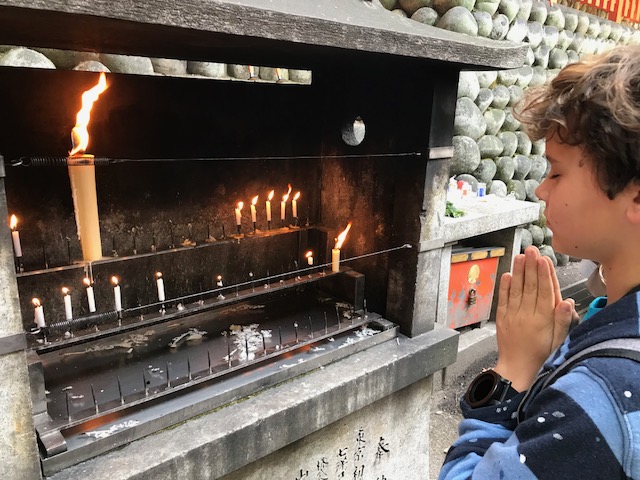While at Todai-ji, the temple in the city of Nara, I was mesmerized looking at the largest Buddha ever built in bronze, when the concept of the “Warrior’s Way” jolted my memory.
The Warrior’s Way was the framework Carlos Castaneda used to describe living life with impeccability and purpose. It consists of a series of premises and behaviors to have direction in one’s life, like experiencing meaningful relationships and acting with clear intentions.
Meaning, purpose, and direction were what my life was lacking when I met Castaneda. It was 1995, and I had decided to move from Argentina to the US to study this way of being, which became an integral part of my life.
The premises in the Warrior’s Way include the impeccable use of one’s attention for enhancing one’s life, and specific behaviors to live life with vitality and daring, such as regular exercises, practices for enhancing the ability to focus and redirecting one’s thoughts, cultivating inner silence, using food to develop one’s perception and health, working with intention, and sharpening the physical body as the perceiver.
The memory of my first years under Castaneda’s rigorous physical training flowed through my body as I was watching the Buddha.
I had arrived in Tokyo three days prior with my ten-year-old son, to join a couple of friends and a guide to do a ‘mystical’ journey visiting large temples in the main cities of Japan. We took a train from Kyoto to Nara to visit the Great Buddha Hall, which is the largest wooden structure in the world built to protect this Buddha.
I felt dizzy from the jetlag and the long hours we spent on trains from Tokyo to Mount Fuji to Kyoto. Nonetheless a feeling of wonder was growing in me. The trains were crowded and sometimes we waited in long lines. Eventually, they moved faster, holding a mood of respect and acknowledgment for the other.

All transportation showed up on time, and, unlike many cities with large volumes of tourism, no trash was visible anywhere. The streets of Kyoto were ‘dressed’ by the cherry blossom trees blooming, smelling sweet, like the first taste of ice cream. They exuded a pinkish-white color that looked like kindness. Japan, in my first impression, radiated life, purpose, and a mood of reverence that nurtured my soul. It resonated in me as the mood of a warrior.
After feeding the deer that roamed the grounds of Todai-ji, which are regarded as messengers of the gods, we passed the first gate of the temple. As I had done in the previous temples, I washed my hands and mouth from the wheel of the dragon.
A large pit with burning incense was the next step. I held the fire in the white candle and I placed it at the feet of the Buddha in gratitude for our Path with Heart community. The sunlight was entering the temple and I inhaled it through my mouth, as Shanti, my guide and a Mayan leader, taught me.
Each step towards the Buddha served to quiet my thoughts and moved my attention to a growing sentiment of vulnerability and amazement. As if every moment in my life had been built for me to arrive to Todai-ji and experience the majesty of the warrior. The words of Castaneda kept rushing fresh into my mind:
“A warrior must cultivate the feeling that he has everything needed for the extravagant journey that is his life. What counts for a warrior is being alive. Life in itself is sufficient, self-explanatory and complete. Therefore, one may say without being presumptuous that the experience of experiences is being alive.” – Carlos Castaneda
I was alive, and aware. My son asked me if Buddha had been also a child, and what happened to him to become a Buddha. What did he do? he wondered. I an attempted to say something coherent to his age and level of understanding. He may have noticed my struggle because he interrupted my thinking and said: “I think I got it. Buddha just kept meditating.”

We walked behind the Buddha and found a line of people “trying to pass through” a hole of the same size of the nostrils of the Buddha. People believe that if one got through the Buddha’s nostrils, one was blessed with his breath. (See video)
We left the temple filled with reverence and gratefulness.
Castaneda used to tell me about his experiences with Kowayashi, a Japanese mentor he had, before meeting don Juan Matus, his spiritual teacher. He said that Kowayashi was the first one that taught him about a specific aspect of the Warrior’s way: Living with simplicity. Castaneda was a master at that. Except for a chair, a couch and a TV, his house had no furniture, no paintings on the pale walls, no mirrors, no decorations.
There were large, clear spaces to practice movements and silence. In his closet, which I once peeked in, he had 2 pairs of jeans, a few t-shirts and 2 tailored suits. All of his cabinets had just a few items. There was breathable space everywhere through out the house, filled with purpose and silence.
My hostel room in Kyoto had two futons that we rolled during the day to set a small table on the tatami for snack and breakfast. The absence of objects and material belongings is what made the space hold a particular calm and peace. It was a reminder of living the beauty of simplicity and the purpose of strength knowing that “the experience of experiences is being alive.”
One action I took when I got back to Los Angeles was to let go of extra material belongings. I am in this process now, creating spaces for silence to flow through.

